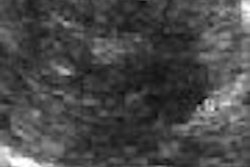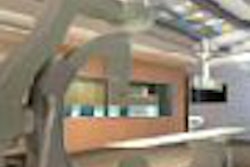CHICAGO - A 15-minute, inexpensive procedure using ultrasound guidance and local anesthesia can relieve severe, disabling shoulder pain caused by calcific tendinitis of the rotator cuff, physicians from Italy reported at the 2007 RSNA meeting. The procedure actually liquefies the calcium deposits in the shoulder and removes them from the body, giving relief that begins within 48 hours after treatment and may last up to 12 years, they said.
"This is a quick, successful, and inexpensive therapy for tendon calcification," said Dr. Luce Sconfienza, a radiologist at Azienda Ospedaliera Ospedale Santa Corona in Pietra Ligure. Costing about $100, the procedure can be completed within 10 minutes. It is better than 90% effective in removing at least 50% of the calcium causing the pain and loss of mobility in the shoulder.
In contrast, Sconfienza said open surgery can cost at least $5,100 and requires a minimum of two months for recovery; shockwave therapy costs about $500 and requires repeat treatments.
Patients with severe shoulder pain are first injected under ultrasound guidance with an anesthetic in the area of the rotator cuff, Sconfienza explained. "They have about five seconds of discomfort from that injection," he said. Then, also using ultrasound guidance, a 16-guage needle is positioned inside the calcium capsule. Next, a second needle is guided into the calcium. A saline solution is pushed into the capsule through one needle using just the pressure from a syringe. Then the solution is recovered as it flows out through the second needle.
The saline solution dissolves the calcium, which is expelled with the solution, Sconfienza said.
"We don't know why some people develop these calcifications," he said. There is no correlation between the calcifications and dominant arm use or type of employment. For some reason, a reduced blood supply occurs in the shoulder, causing changes in the tendon environment that result in calcium crystal deposits. Buildup of these deposits can cause inflammation and continual pain -- even during sleep -- and can impact the ability to use the arm, Sconfienza said.
Without treatment, the pain increases until it reaches a crisis point, then the capsule ruptures. The rupture results in pain relief, but it can take as long as two years before the patient is pain-free. The condition occurs in otherwise healthy shoulders, and is more frequent in women than men, more often between the ages of 30 to 40 but ranges from ages 25 to 75.
In his RSNA presentation, Sconfienza reported the results from a series of 2,788 patients -- 990 men and 1,798 women, ranging in age from 29 to 73 years of age -- who had undergone the procedure. In 70.1% of the cases, the calcium was completely extracted during the procedure, and greater than 50% of calcium was extracted in another 23.5% of the patients. In 4.1% of patients, the calcium was reduced less than 50%; the calcium level was unchanged in 2.1% of patients.
At one-year follow-up, patients were found to have a 34.3% improvement compared with baseline and a 61% relief in pain based on visual analog scale scores of the patients. In up to 12 years of follow-up, patients have reported no incidence of recurrence or complications.
"Under precise ultrasound guidance, this procedure is more effective than others in the treatment of calcific shoulder," Sconfienza concluded. He noted that his two-needle procedure differs from other percutaneous treatments by being able to remove greater amounts of calcium from the shoulder space.
"This calcium buildup occurs in a lot of joints," said Dr. Philip Alderson, the James Picker Professor and chairman of radiology at Columbia University in New York City, who moderated a press briefing at which the Italian study was discussed. He explained that the saline injection into the calcium capsule loosens the gel-like matrix so it can be flushed out. He suggested the procedure could be used in joints as well as the shoulder.
By Edward Susman
AuntMinnie.com contributing writer
November 28, 2007
Related Reading
Preop US targets shoulder calcium deposits while US therapy quashes pain, September 4, 2007
US-guided interventional procedures boost sports medicine performance, May 3, 2007
US shows full spectrum of shoulder injuries, September 29, 2006
Copyright © 2007 AuntMinnie.com



















